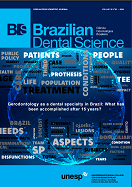Incidental findings of bone alterations in temporomandibular joints in cone-beam computed tomography scans adquired for implants planning: the importance of complete field of view analysis
DOI:
https://doi.org/10.14295/bds.2016.v19i2.1243Abstract
Objective: to evaluate the frequency of bone alterations in temporomandibular joints (TMJ) in of cone beam computed tomography (CBCT) images, with dental implats planning purpose. Material and Methods: 148 cone beam exames were selected from the file of the Radiology Clinic ICT UNESP. All the images were performed by Next Generation i-CAT (Imaging Sciences Ltda, Hatfield, PA, USA) scanner, using voxel of 0.20/0.25 mm and FOV of 16.0 x 13.0 cm for dental implants planning. All the images should show both (rigth and left) TMJ condyle. The TMJ condyle were reformated using TMJ protocol, with parassagital slices, perpendicular to the long axis of TMJ condyle, in order to study presence of the following bone alterations: osteophytes, erosion, flatenning, bone sclerosis and cortical thinning. Results: The results showed that 63.51% of the sample belonged to female and 36.49% to male. In addition, it was noted that the most frequent bone alterations in condyle were osteophytes (56.75%) and flatening (55.4%). The erosion was the alteration with lower frequency (0,67%). The statistic test of Mcnemar showed that there was relationship between flatening and erosion, flatening and bone sclerosis, flatening and cortical thinning, erosion and osteophytes, bone sclerosis and cortical thinning (p<0.0001), in both sides. There was no relationship between flatening and osteophytes, erosion and bone sclerosis, erosion and cortical thinning (p>0.01). Conclusion: the hight frequency of bone alterations findings in TMJ condyle was an indicator of the importance of the analysis of all the structures present in the CBCT FOV, regardless its indication.
Downloads
Downloads
Additional Files
Published
How to Cite
Issue
Section
License
Brazilian Dental Science uses the Creative Commons (CC-BY 4.0) license, thus preserving the integrity of articles in an open access environment. The journal allows the author to retain publishing rights without restrictions.
=================




























